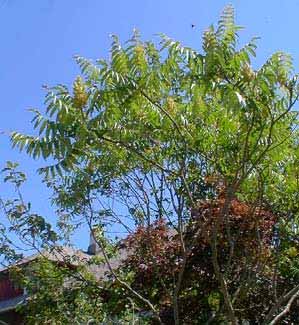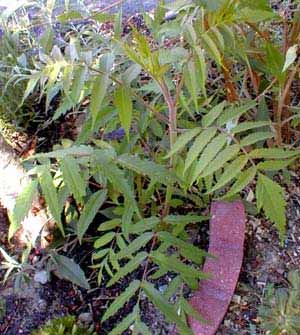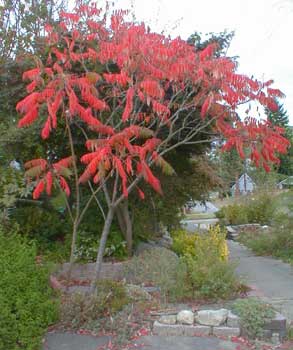
Staghorn Sumac
"That tree said
I don't like that white car under me,
it smells of gasoline."
-Allen Ginsberg
(1926-1997)
(1926-1997)
Out on the street corner in an extremely sunny & summer-dry location, we have a young Staghorn Sumac ( Rhus typhina) of about thirteen feet of height (as of 2003; a bit taller with a much wider leaf crown in 2005).
It will never be a huge tree, & is sometimes defined as a large deciduous shrub. It typically reaches nine to fifteen feet in gardens, only rarely twenty-five feet, even though in the wild it occasionally reaches thirty to forty feet.
The flattened leaf crown on ours is very wide at the open top, completely overhanging the sidewalk & shading much of the corner. The upper branches of staghor sumac will spread out as wide as the tree is tall.
 The tree re-leafs very late in spring. On the Chokecherry page you can barely make out the skeletal outline of the staghorn sumac in front of a fully blooming chokecherry, shot in May (2003). On another page, there's a second May photo showing the naked sumac from a slightly different angle, in front of a fully leafed Japanese maple.
The tree re-leafs very late in spring. On the Chokecherry page you can barely make out the skeletal outline of the staghorn sumac in front of a fully blooming chokecherry, shot in May (2003). On another page, there's a second May photo showing the naked sumac from a slightly different angle, in front of a fully leafed Japanese maple.Gardeners have to get used to its limbs being bare for so long into spring. For its first couple of years, Granny Artemis & I would watch it a little apprehensively, wondering if it died. But then it gets a few leafy tufts, relieving our worries, then practically overnight it has returned to full leaf.
The leaves have a fern-frond appearance. It is not the leaves that are supposed to look like staghorns, but it is the fuzziness of young limbs that is supposed to cause the forking winter branches to resemble the furriness on antlers, hence also the alternate name Velvet Sumac. The trunk & oldest limbs cease to be velvety with age.
 About the same time as its leaves are restored, it produces eight inch tall upright panicles of flowers which, from the ground, look like yellow-green conical pyramids. The tree is dioecious meaning on some trees all the flowers are male, on others female.
About the same time as its leaves are restored, it produces eight inch tall upright panicles of flowers which, from the ground, look like yellow-green conical pyramids. The tree is dioecious meaning on some trees all the flowers are male, on others female.On the female trees the flowers turn into rust-red "fuzzy fruits" by mid or late summer. These inverted bunches of furry drupes are liked by a few large gamebirds, squirrels, moose & deer. A traditional lemonade-like beverage is made from the berries, which are also used for home jellies.
The fruits ripen in autumn & for a while share the limbs with extremely vibrant golden & red autumn leaves, then persist into winter lending decorativeness to the limbs even after leaves have fallen.
It's hard from the ground to get a good shot of the top of the tree, but the first photo above snapped in June (2004) had the camera aimed upward through the branches attempting to capture the pyramidal flowers.
By late September or early October, the autumn leaves are very beautiful. But the leaves fall so suddenly, its display is shortlived. The third photo shows the color in September (2005). You can see more autumn color photos on the Staghorn Sumac Page of the Autumn Trees Gallery.
It is extremely resistant to diseases, though here in the northwest it is one of the trees susceptible to verticillium wilt. It would be an entirely no-maintenance little tree except for its strong tendency to sucker; to keep a single-trunked specimen tree-like in form requires the removal of suckers as they appear.
The second photo snapped at the beginning of July shows one of the suckers which sprang up from nothing to three feet tall in just a couple of months. We decided to permit this sucker to develop so that it will develop a second trunk. But other suckers we've removed. They can appear as far as six or twelve feet from the main tree, but are not strongly attached as they're easily pulled right out of the ground with its own roots. These can be transferred to pots to be given away as gifts, although such potted starts will have to be carefully babied for a while or they will shrivel & die.
Its natural range is eastern North America, from Cape Breton Island & Nova Scotia to South Carolina, & from the Great Lakes region into the upper midwest. It is fond of disrupted dry soils & frequently grows at forest edges, & can even colonize strip-mine areas that have lost their topsoil & support few other trees. It does not penetrate into old forests, as it is not tolerant of shade.